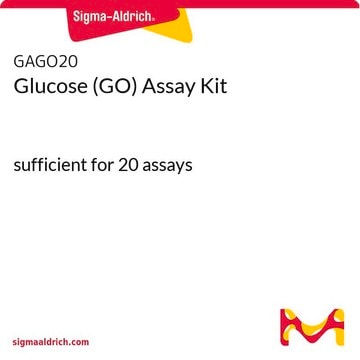This product is not tested for DNase. Since such a grade (i.e., a Molecular Biology grade) is not listed for D-Glucose, it is recommended to autoclave the imaging buffer for 15 minutes at 121°C to degrade any DNase that might be present. Allow the imaging buffer to cool to room temperature prior to addition of the glucose oxidase and catalase enzymes. Autoclaving may introduce some yellow color to the imaging buffer due to caramelization of a small portion of the D-Glucose, but that color should not interfere with the imaging process.
G5767
D-(+)-Glucose
ACS reagent
Synonym(s):
Dextrose
About This Item
Recommended Products
biological source
wheat
Quality Level
grade
ACS reagent
form
powder
optical activity
[α]25/D +52.5 to +53.0°(lit.)
impurities
Starch, passes test
≤0.002 meq/g Titratable acid
≤0.005% Insoluble matter
ign. residue
≤0.02%
loss
≤0.2% loss on drying, 105°C
color
colorless
mp
150-152 °C (lit.)
anion traces
chloride (Cl-): ≤0.01%
sulfate, sulfite (as SO42-): ≤0.005%
cation traces
Fe: ≤5 ppm
heavy metals: ≤5 ppm (by ICP-OES)
storage temp.
room temp
SMILES string
OC[C@H]1O[C@H](O)[C@H](O)[C@@H](O)[C@@H]1O
InChI
1S/C6H12O6/c7-1-2-3(8)4(9)5(10)6(11)12-2/h2-11H,1H2/t2-,3-,4+,5-,6+/m1/s1
InChI key
WQZGKKKJIJFFOK-DVKNGEFBSA-N
Gene Information
human ... PYGM(5837)
Looking for similar products? Visit Product Comparison Guide
General description
Application
- as a supplement in Dulbecco′s phosphate-buffered saline (DPBS) for standardized serum bactericidal assay (SBA) using human complement
- as a component in 4-(2-hydroxyethyl)-1-piperazineethanesulfonic acid (HEPES)-buffered Tyrode′s solution to treat the excised diaphragmatic specimens to assess the effect of osmolarity changes on the intrinsic lymphatic pumping mechanism
- to study the effect of restoring circulating glucose content in insulin-responsive neurons of rats
- for oral glucose tolerance tests (OGTTs)
Biochem/physiol Actions
Preparation Note
Other Notes
Storage Class Code
11 - Combustible Solids
WGK
WGK 1
Flash Point(F)
Not applicable
Flash Point(C)
Not applicable
Personal Protective Equipment
Choose from one of the most recent versions:
Certificates of Analysis (COA)
Don't see the Right Version?
If you require a particular version, you can look up a specific certificate by the Lot or Batch number.
Already Own This Product?
Find documentation for the products that you have recently purchased in the Document Library.
Customers Also Viewed
-
Is this glucose tested for DNAse? If not, which glucose (catalogue no.) should I use to get DNAse free solution that I intend to use as imaging buffer, supplemented with glucose oxidase and catalase, for imaging DNA strands?
1 answer-
Helpful?
-
-
How can I determine the shelf life / expiration / retest date of this product?
1 answer-
If this product has an expiration or retest date, it will be shown on the Certificate of Analysis (COA, CofA). If there is no retest or expiration date listed on the product's COA, we do not have suitable stability data to determine a shelf life. For these products, the only date on the COA will be the release date; a retest, expiration, or use-by-date will not be displayed.
For all products, we recommend handling per defined conditions as printed in our product literature and website product descriptions. We recommend that products should be routinely inspected by customers to ensure they perform as expected.
For products without retest or expiration dates, our standard warranty of 1 year from the date of shipment is applicable.
For more information, please refer to the Product Dating Information document: https://www.sigmaaldrich.com/deepweb/assets/sigmaaldrich/marketing/global/documents/449/386/product-dating-information-mk.pdfHelpful?
-
-
How is shipping temperature determined? And how is it related to the product storage temperature?
1 answer-
Products may be shipped at a different temperature than the recommended long-term storage temperature. If the product quality is sensitive to short-term exposure to conditions other than the recommended long-term storage, it will be shipped on wet or dry-ice. If the product quality is NOT affected by short-term exposure to conditions other than the recommended long-term storage, it will be shipped at ambient temperature. As shipping routes are configured for minimum transit times, shipping at ambient temperature helps control shipping costs for our customers. For more information, please refer to the Storage and Transport Conditions document: https://www.sigmaaldrich.com/deepweb/assets/sigmaaldrich/marketing/global/documents/316/622/storage-transport-conditions-mk.pdf
Helpful?
-
Active Filters
Our team of scientists has experience in all areas of research including Life Science, Material Science, Chemical Synthesis, Chromatography, Analytical and many others.
Contact Technical Service



